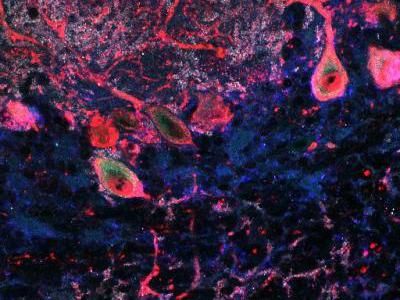Unraveling brain circuits involved in cravings
Dartmouth researchers studying rats have discovered that activation of designer neural receptors can suppress cravings in a brain region involved in triggering those cravings.
The study is the first to systematically show how designer brain receptors and designer drugs work together to change how cues for food stimulate motivation. The findings may help scientists to fight addiction, overeating and other habitual behavior in humans.
In everyday life, we are bombarded with advertisements, or cues, that garner our attention and trigger us into purchasing products, or rewards. Consequently, these reward-paired cues can become attractive themselves. For example McDonald's golden arches can produce cravings for fast food even though you haven't seen the food or aren't even hungry. Scientists study this phenomenon using sign-tracking, or autoshaping, an experimental conditioning in which the reward is given regardless of the subject's behavior.
"Although we have a sense of what brain circuits mediate reward, less is known about the neural circuitry underlying the transfer of value to cues associated with rewards," says lead author Stephen Chang , a postdoctoral fellow. "We were primarily interested in whether the ventral pallidum, a brain region implicated in processing reward, is also involved in sign-tracking."
Previously, it was impossible to inactivate brain areas like this repeatedly and temporarily to study how cues become valuable in themselves. But it is now possible with a new technology called DREADDs (designer receptors exclusively activated by designer drugs). Your brain cells are loaded with natural receptors, or molecules like jigsaw puzzles that are activated when another molecule arrives that fits like a missing piece. But DREADDs are engineered receptors introduced into neurons using viruses. Injection of a synthetic drug can activate these receptors, thus shutting down the neurons as a sort of remote control.
This technology allowed the Dartmouth researchers to inactivate the ventral pallidum repeatedly and temporarily during tests in which a lever was inserted into the experimental chamber for 10 seconds, followed by a food pellet reward when the lever was withdrawn. Even though the food was delivered regardless of the rats' behavior, the rats pressed and bit the lever as if it were the reward itself. The results showed that activating DREADDs in the ventral pallidum before each training session blocked that behavior. In addition, recordings of individual neurons in the ventral pallidum following DREADD activation showed that ventral pallidum activity can become suppressed or excited to varying speeds and amounts.
"These results are the first to show that the ventral pallidum is necessary for the attribution of value to cues that are paired with rewards," Chang says. "This is surprising because the ventral pallidum was historically considered to be just an area for expressing motivations in behavior. In terms of clinical applications, the results carry the potential for stripping away value from reward-paired cues in cases such as addiction. The ventral pallidum is a novel target for such work."
Original publication
Other news from the department science

Get the life science industry in your inbox
By submitting this form you agree that LUMITOS AG will send you the newsletter(s) selected above by email. Your data will not be passed on to third parties. Your data will be stored and processed in accordance with our data protection regulations. LUMITOS may contact you by email for the purpose of advertising or market and opinion surveys. You can revoke your consent at any time without giving reasons to LUMITOS AG, Ernst-Augustin-Str. 2, 12489 Berlin, Germany or by e-mail at revoke@lumitos.com with effect for the future. In addition, each email contains a link to unsubscribe from the corresponding newsletter.


















































